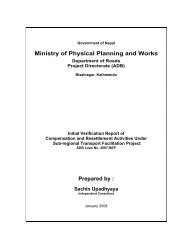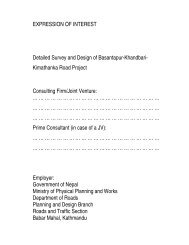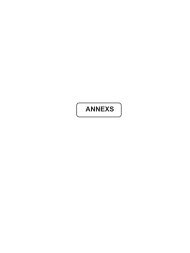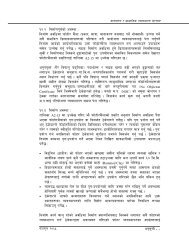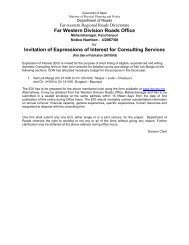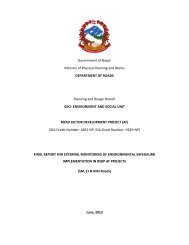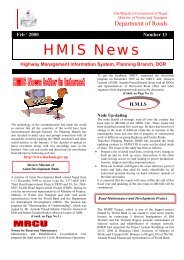NEPAL VEHICLE OPERATING COSTS - About Department of Road
NEPAL VEHICLE OPERATING COSTS - About Department of Road
NEPAL VEHICLE OPERATING COSTS - About Department of Road
Create successful ePaper yourself
Turn your PDF publications into a flip-book with our unique Google optimized e-Paper software.
His Majesty’s Government <strong>of</strong> Nepal<br />
Ministry <strong>of</strong> Physical Planning & Works<br />
<strong>Department</strong> <strong>of</strong> <strong>Road</strong>s<br />
WORKING PAPER<br />
ROAD USER <strong>COSTS</strong><br />
MRCU- MAINTENANCE AND REHABILITATION<br />
CO-ORDINATION UNIT<br />
December 2001
Working Paper – Vehicle Operating Costs<br />
Table <strong>of</strong> Contents<br />
TABLE OF CONTENT<br />
1. INTRODUCTION ...........................................................................................1<br />
2. TRUCK SURVEY RESULTS.........................................................................2<br />
3. BUS SURVEY RESULTS..............................................................................4<br />
4. OUTSTANDING ISSUES ..............................................................................5<br />
5. A SURVEY OF INPUT PRICES ....................................................................6<br />
6. RECOMMENDED <strong>VEHICLE</strong> <strong>OPERATING</strong> COST INPUT VALUES .............8<br />
7. RECOMMENDED <strong>VEHICLE</strong> <strong>OPERATING</strong> COST EQUATIONS ................12<br />
Suggested modifications compared with 1994...........................................12<br />
Definitions <strong>of</strong> variables:................................................................................13<br />
The VOC Equations.......................................................................................14<br />
LIST OF TABLES<br />
Table 1: Truck Survey (12 th July).......................................................................2<br />
Table 2: Truck Operating Costs and Revenues on a per km basis ................3<br />
Table 3: Bus Survey............................................................................................4<br />
Table 4: Bus Operating Costs and Revenues on a per km basis ...................5
Working Paper – Vehicle Operating Costs Page 1<br />
<strong>NEPAL</strong> <strong>VEHICLE</strong> <strong>OPERATING</strong> <strong>COSTS</strong>, 2001<br />
1. INTRODUCTION<br />
In order to undertake a cost benefit analysis <strong>of</strong> road investment and road maintenance<br />
information on vehicle operating costs (VOC) are required. VOCs are an important<br />
component <strong>of</strong> road planning models such as HDM III and HDM-4. Major research<br />
studies on VOCs have been carried out over the last 25 years in order to establish how<br />
transport costs change with respect to road based parameters such as road roughness,<br />
curvature and gradient.<br />
To use VOC models it is necessary, from time to time, to ensure the following:-<br />
a) The proposed model is appropriate to the circumstances<br />
b) Up-to-date input costs are used<br />
c) Up-to-date vehicle utilisation and other parameters are used.<br />
In the period 1992 to 1994, under the MRCU, a computer spreadsheet program for<br />
VOCs in Nepal was developed. It was subsequently updated in 1996. The program<br />
was designed to provide basic guidance to the <strong>Department</strong> <strong>of</strong> <strong>Road</strong>s and consultants<br />
on VOCs in Nepal. The relationships used in the program were based on the VOC<br />
research carried out in India by the Central <strong>Road</strong> Research Institute. Research has<br />
shown very wide variations in the nature <strong>of</strong> relationships, particularly relating to<br />
vehicle maintenance, between different countries. Because most <strong>of</strong> the trucks and<br />
buses used in Nepal were made by Tata in India and it was felt that the Indian<br />
research would be most appropriate for Nepal. Small scale surveys were undertaken<br />
and the results compared with models to test whether they were broadly appropriate.<br />
Some adjustments were made to relationships in order to obtain a good fit. In<br />
particular adjustments were made to the fuel consumption relationships in order to<br />
suit the conditions found in Nepal.<br />
It has now been recognised that this type <strong>of</strong> calibration is crucial for the successful<br />
adoption <strong>of</strong> the road planning model HDM-4. Within in HDM-4 it is important to<br />
calibrate key relationships relating to both VOCs and road deterioration.<br />
It should be recognised that general price inflation is not a key reason for updating<br />
VOC data. In undertaking a cost benefit analysis <strong>of</strong> a road project both road<br />
maintenance costs and VOCs are forecast for 20 years or more into the future. It is,<br />
or course, necessary for the prices used in calculating road investment, road<br />
maintenance and VOCs to relate to the same date. However, over time, the<br />
relationships between the price components will change (e.g. between fuel and<br />
vehicles), similarly over time, vehicle types and vehicle utilisation will also change<br />
and it for these reasons that up-dating exercise is necessary.<br />
In July 2001 a consultant was appointed to up-date the Nepal VOC model. This task<br />
was undertaken by carrying out some small scale surveys <strong>of</strong> trucks and buses and by<br />
collecting a range <strong>of</strong> input prices relating vehicles, fuel taxation rates etc. The<br />
purpose <strong>of</strong> the surveys is to collect utilisation data and to help test the overall validity
Working Paper – Vehicle Operating Costs Page 2<br />
<strong>of</strong> the models, particularly through estimating revenues and comparing with total<br />
operating costs. The approach taken has been to check the validity and make<br />
adjustments to the VOC model on the basis <strong>of</strong> surveys <strong>of</strong> buses and trucks<br />
operating on good main road. It has not been possible to check the validity <strong>of</strong> the<br />
model in more extreme conditions <strong>of</strong> road roughness and gradient and<br />
curvature.<br />
For road planning purposes “economic” prices need to be used so vehicle operating<br />
costs need to be collected without taxation. Conventional financial prices are also<br />
required in order to test general financial viability. The spreadsheet model deals with<br />
both financial and economic VOCs separately.<br />
2. TRUCK SURVEY RESULTS<br />
A survey was carried out at Thankot on 12 th <strong>of</strong> July in which 42 drivers going to<br />
Kathmandu were interviewed about their current trip, revenues, operating costs and<br />
utilisation. Key data collected and directly estimated is presented in Table 1.<br />
Vehicle Age<br />
Trip Distance<br />
Revenue per trip<br />
Estimate <strong>of</strong> rounds trips/month<br />
Annual distance travelled<br />
Fuel consumption per km<br />
Maintenance costs per month<br />
Crew costs per month<br />
Table 1: Truck Survey (12 th July)<br />
Mean<br />
6 yrs<br />
370 km<br />
8266 Rs<br />
10<br />
83654 km<br />
0.30 lt/km<br />
11754 Rs<br />
7213 Rs<br />
Median<br />
5 yrs<br />
300 km<br />
8000 Rs<br />
10<br />
72000 km<br />
0.266 lt/km<br />
10000 Rs<br />
7375 Rs<br />
The data confirmed that fuel, maintenance and crew costs was closely predicted by<br />
the 1994 MRCU VOC spreadsheet model using the Indian VOC relationships.<br />
However insufficient data was collected on tyre consumption and furthermore<br />
predicted revenues per km were estimated to be very close to direct operating costs<br />
leaving little margin for depreciation, interest charges and overheads. As a result a<br />
further series <strong>of</strong> in-depth interviews were carried out with truck drivers to assess their<br />
operating costs and revenues. Good estimates <strong>of</strong> oil and tyre consumption was<br />
collected together with more information on truck revenues.<br />
The in-depth interviews revealed that tariffs during the “summer” months were<br />
usually (by about 22%) lower than during the “winter” months. In addition some<br />
drivers take advantage <strong>of</strong> the higher tariffs by operating more frequently. Furthermore<br />
there seems less scope now than previously to collect return trip loads. Overall return<br />
trips accounted for only 2% <strong>of</strong> total revenue on the Kathmandu run compared with<br />
previous estimates <strong>of</strong> about 5.5% that was found from studies in the early 1990s.
Working Paper – Vehicle Operating Costs Page 3<br />
Data from the main truck survey and the in-depths interviews was converted to a per<br />
kilometre basis and compared with the 1994 VOC model predictions using current<br />
financial prices. <strong>Road</strong> data for the Kathmandu –Birgunj route was used in the<br />
analysis. The key road based parameters were: IRI: 5.21 m/km, curvature 189 degs<br />
per km and rise and fall 19m/km. The data is presented in Table 2.<br />
The table shows that currently trucks are operating with revenues very close to<br />
operating costs. In fact many operators do not appear to be covering their long run<br />
standing costs. In both surveys drivers confirmed that they were well aware <strong>of</strong> very<br />
low margins between revenues and direct costs.<br />
Table 2: Truck Operating Costs and Revenues on a per km basis<br />
Fuel<br />
Oil<br />
Tyres<br />
Maintenance<br />
Crew<br />
Total variable costs<br />
Depreciation<br />
Interest<br />
Overheads<br />
Total operating costs<br />
Estimated revenues<br />
Main Truck<br />
Survey<br />
N Rs/km<br />
7.959<br />
-<br />
-<br />
1.686<br />
1.305<br />
In-Depth<br />
Interviews<br />
N Rs / km<br />
1994 VOC model<br />
N Rs /km<br />
13.28 1 15.5 2<br />
7.766<br />
7.813<br />
0.336<br />
0.626<br />
1.968<br />
1.514<br />
1.649<br />
1.770<br />
1.035<br />
1.098<br />
12.754<br />
12.821<br />
-<br />
-<br />
1.512<br />
-<br />
-<br />
1.010<br />
-<br />
-<br />
0.504<br />
15.847<br />
-<br />
-<br />
Notes<br />
1. Without adjustment for greater revenues and utilisation in the six winter months<br />
2. With adjustment for greater revenues and utilisation in the six winter months<br />
On the basis <strong>of</strong> the data collected it was noted that oil consumption is lower than<br />
predicted while tyre wear is higher than predicted. ”. In discussions it was found that<br />
oil consumption is relatively easy to estimate. As a result it is recommended that the<br />
Indian oil consumption relationship be multiplied by a factor <strong>of</strong> “0.54”. Although<br />
tyre consumption is relatively difficult to estimate, because <strong>of</strong> the complication <strong>of</strong> the<br />
joint use <strong>of</strong> both new and remoulded tyres, however the difference between observed<br />
and predicted was thought to sufficient to justify a new correction factor. It<br />
recommended that tyre wear is multiplied by a factor <strong>of</strong> “1.37”. Currently vehicles<br />
are using particularly cheap tyres and their wearing quality may now be poorer than<br />
before.<br />
In the previous model fuel consumption was increased by 30% over the Indian model<br />
estimate to meet observed fuel consumption in Nepal. This was achieved by<br />
multiplying by a given factor. It is now proposed to achieve the same result by adding
Working Paper – Vehicle Operating Costs Page 4<br />
a constant factor. This will have the effect <strong>of</strong> reduce total fuel consumption for more<br />
extreme conditions.<br />
New VOC input prices and utilisation rates should be applied to the truck VOC<br />
relationships.<br />
3. BUS SURVEY RESULTS<br />
A bus survey was carried out at the main bus station in Kathmandu. In total 22 drivers<br />
were interviewed about their operations. Key survey data are presented in the table 3.<br />
below:<br />
Vehicle Age<br />
Trip Distance<br />
Revenue per trip<br />
Estimate <strong>of</strong> rounds trips/month<br />
Annual distance travelled<br />
Fuel consumption per km<br />
Maintenance costs per month<br />
Crew costs per month<br />
Revenue per km<br />
Table 3: Bus Survey<br />
Mean<br />
3 yrs<br />
425 km<br />
9802 Rs<br />
5.2<br />
52,407 km<br />
0.438 lt/km<br />
11,550 Rs<br />
14,053 Rs<br />
23.3<br />
Median<br />
2 yrs<br />
436 km<br />
8862 Rs<br />
4.5<br />
38,016 km<br />
0.336 lt/km<br />
9,250 Rs<br />
14,400 Rs<br />
21.1<br />
An estimate <strong>of</strong> variable bus operating costs is presented in Table 2. together with an<br />
estimate <strong>of</strong> operating costs derived from the 1994 MRCU vehicle operating cost<br />
model. As with the truck data the VOC model uses data for the Birgunj –Kathmandu<br />
route.<br />
As can be seen bus operating revenues are in the order <strong>of</strong> being 50% higher than<br />
trucks on a per km basis. The bus survey found that the annual distance travelled was<br />
lower because buses spent a lot <strong>of</strong> time queuing at the bus terminal, <strong>of</strong>ten for several<br />
days at a time, waiting for their turn. The cost analysis suggests that revenues are<br />
comfortably above costs. There are a number <strong>of</strong> indications that buses are currently<br />
much more pr<strong>of</strong>itable than trucks. Crew wages are much higher and the fleet age<br />
appears younger. The low trip rate and extensive queuing indicates that there is an<br />
oversupply <strong>of</strong> buses.
Working Paper – Vehicle Operating Costs Page 5<br />
Table 4: Bus Operating Costs and Revenues on a per km basis<br />
Fuel<br />
Oil<br />
Tyres<br />
Maintenance<br />
Crew<br />
Direct costs<br />
Depreciation<br />
Interest<br />
Overheads<br />
Total Operating Costs<br />
Revenue<br />
Bus Survey<br />
N Rs /km<br />
8.809 (median)<br />
-<br />
-<br />
2.018 (median)<br />
2.892 (median)<br />
-<br />
-<br />
-<br />
21.1 to 23.3<br />
VOC model<br />
N Rs / km<br />
6.836<br />
0.626<br />
1.417<br />
1.477<br />
3.174<br />
13.530<br />
2.351<br />
1.571<br />
1.151<br />
18.603<br />
An exact comparison with the VOC model was not as easy to achieve, compared with<br />
the trucks, because <strong>of</strong> the more varied nature <strong>of</strong> the bus operations surveyed. Bus trip<br />
lengths were longer as many buses travelled on routes to west and east Nepal where<br />
road roughness is higher than on the main truck route to Birgunj. The higher, than<br />
predicted, maintenance and fuel costs may be explained, in part, by this difference in<br />
road conditions. The components that do not vary directly with travel (ie. Crew,<br />
depreciation, interest, overheads ) are higher for buses than for trucks because <strong>of</strong> the<br />
lower levels <strong>of</strong> utilisation.<br />
In Nepal the Tata trucks and buses are based on a very similar vehicle type and it is to<br />
be expected that the model relationships used should be fairly similar because the<br />
vehicle and the component parts are very similar and have similar prices. However<br />
differences in operating costs can arise not only from the different road conditions but<br />
from the different driving behaviour and different vehicle loading. Buses tend to drive<br />
faster while trucks are much more heavily loaded.<br />
Overall it was felt that there was insufficient basis to change the bus VOC<br />
relationships. However it is recommended that the changes relating to oil<br />
consumption and tyres for trucks should also be applied to buses. New utilisation<br />
rates and VOC prices should also be applied.<br />
4. OUTSTANDING ISSUES<br />
It should be recognised that considerable uncertainty still exists on the nature <strong>of</strong> VOC<br />
relationships in Nepal. This is particularly the case for how VOCs behave on rougher<br />
roads and roads with more extreme gradient and curvature. If possible research<br />
should be carried out to check how fuel consumption, tyre wear and maintenance<br />
costs vary away from the main road network. The Indian VOC relationships show
Working Paper – Vehicle Operating Costs Page 6<br />
much greater sensitivity <strong>of</strong> fuel consumption to road roughness than other models<br />
including HDM4.<br />
It is also recommended that research is carried out to check passenger values <strong>of</strong> time.<br />
There are now relatively simple methods using stated preference techniques to do this.<br />
5. A SURVEY OF INPUT PRICES<br />
The following data was collected from a variety <strong>of</strong> sources including vehicle dealers,<br />
mechanics ,tyre distributors the national insurance company.<br />
Vehicles<br />
With tax<br />
Without tax<br />
Tata Truck<br />
SE 1613 chassis 1197000 910266<br />
Body 235000 210762<br />
Total 1432000 1121028<br />
Tata Truck<br />
LPT 1613 chassis 1260000 958175<br />
Body 235000 210762<br />
Total 1495000 1168937<br />
Small Truck LP 709E 992000 754372<br />
Tata Bus LP1512 1157000 847619<br />
Body 375000 336322<br />
Total 1532000 1183941<br />
Small bus LP407 836,000 551815<br />
Body 200,000 179372<br />
Total 1,036,000 731187<br />
Utility Tata Sumo 1836000 1396198<br />
Toyota Lancruiser Prado 2738344 1964554<br />
Nissan Pickup 1730000 1252000<br />
Maruti Gypsy utility 1336500 1016350<br />
Maruti car 831600 632395<br />
Nissan sunny 1344250 950000<br />
Toyota Echo 1051065 756000<br />
Tyres<br />
Truck / Bus Tyre India 15000 10950<br />
Nepal 11000 9821<br />
Truck remould 3000 2679
Working Paper – Vehicle Operating Costs Page 7<br />
Mini Truck Nepal 6000 5357<br />
Mini Bus Nepal 3700 3304<br />
Small Car Chinese 1000 727<br />
Small Car Malay/Indonesia 3000 2182<br />
Remould 450 402<br />
Pickup Chinese 1450 1054<br />
Malay/Indonesia 4500 3273<br />
Fuel<br />
Petrol ltr 46 30.76<br />
Diesel ltr 26.5 21.26<br />
Lubricants Truck/bus ltr 150 98.7<br />
Car ltr 250 164.5<br />
Insurance<br />
Annual premium:<br />
Truck value 1000,000 15925<br />
Truck value 2,000,000 28425<br />
Bus 40 seats value 1,000,000 18660<br />
Pick-up value 1,000,000 14390<br />
Maruti Car value 800,000 16205<br />
Annual Vehicle Tax Petrol Diesel<br />
Truck /Bus 11,500 12,700<br />
Minitruck/ bus 7,400 8,700<br />
Car under 1300 cc 6,500 10,000<br />
1300-2000 cc 8,500 13,750<br />
2100-2900 cc 10,000 17,500<br />
3000-4000 cc 12,300 23,000<br />
Maintenance Labour<br />
Different garage charge rates:<br />
107 Rs/hr , 375 Rs/hr , 108 Rs/hr , 230 Rs/hr<br />
Earnings:<br />
Senior Mechanic 3500 Rs/ month truck wayside garage<br />
Helper / mechanic 2000 Rs/month truck wayside garage<br />
---------------<br />
average<br />
2750 Rs/ month i.e. per hour = 19.6 Rs/hr
Working Paper – Vehicle Operating Costs Page 8<br />
6. RECOMMENDED <strong>VEHICLE</strong> <strong>OPERATING</strong> COST INPUT<br />
VALUES<br />
It is now standard practise to subtract tyre costs from the new vehicle prices to be<br />
applied in VOC models on the basis that tyre costs are modelled separately. However<br />
in view <strong>of</strong> the fact that manufacturers buy tyres at a much lower cost than general<br />
public, that tyre distribution costs are much lower and that tyre consumption formulae<br />
do not take into account the associated interest costs it is recommended that only half<br />
<strong>of</strong> the tyre costs are subtracted.<br />
With Tax<br />
Without<br />
Tax<br />
Truck LPT 1613 1,495,000 1,168,937<br />
Less tyre correction (3 tyres) - 33,000 - 29,463<br />
----------------------------------------<br />
1,462,000 1,139,474<br />
Mini Truck LP709 992,000 754,372<br />
Less tyre correction (3 tyres) - 18,000 - 16,071<br />
-----------------------------------------<br />
-<br />
974,000<br />
738,301<br />
Bus LP1512 1,532,000 1,183,941<br />
Less tyre correction (3 tyres) - 33,000 - 29,463<br />
----------------------------------------<br />
1,499,000 1,154,478<br />
Minibus LP407 1,036,000 731,187<br />
Less tyre correction (3 tyres) - 11,100 - 9,900<br />
---------------------------------------<br />
1,024,900 721,287<br />
Utility: composite <strong>of</strong> three vehicles:<br />
Nissan Pickup 1,730,000 1,252,000<br />
Maruti Gypsy 1,336,500 1,016,350<br />
Toyota Landcruiser Prado 2,700,000 1,934,554<br />
------------------------------------------<br />
Average 1,924,948 1,400,851<br />
Less tyre correction (2 tyres) -5950 - 4328<br />
-------------------------------------------<br />
1,928,998 1,406,523<br />
Car : Composite <strong>of</strong> three vehicles:<br />
Maruti 831,600 632,395<br />
Nissan sunny 1,344,250 950,000<br />
Toyota echo 1,051,065 756,000
Working Paper – Vehicle Operating Costs Page 9<br />
----------------------------------------<br />
Average 1,075,638 779,465<br />
Less tyre correction (2 tyres) -4000 -2909<br />
-------------------------------------<br />
1,071,638 776,556<br />
Tyres: Large Bus /Truck (Nepalese) 11,000 8,030<br />
Mini Truck 6,000 5,354<br />
Mini Bus 3,700 3,304<br />
Utility Composite <strong>of</strong><br />
Chinese 1,450 1,054<br />
Malay/Indonesian 4,500 3,273<br />
----------------------------------<br />
average 2,975 2,164<br />
Car: 1000 727<br />
Fuel &Lubricant Costs:<br />
Petrol 46 30.76<br />
Diesel 26.5 21.26<br />
Lubricating Oil 175 115.15<br />
Crew Costs month<br />
Truck 7,375 7,375<br />
Mini truck 6,225 6,225<br />
(less half <strong>of</strong> one assistant at 2300)<br />
Bus 14,053 14,053<br />
Mini bus 11,053 11,053<br />
( less one conductor at 3000)<br />
Utility 4,500 4,500<br />
(one driver plus allowances est)<br />
Car 2,250 2,250<br />
(half <strong>of</strong> driver plus allowances est.)<br />
Maintenance Labour: 20 Rs/ Hr 20 Rs/Hr<br />
Overhead and Insurance Costs:<br />
Say: 2% <strong>of</strong> new taxed value + insurance + annual tax for buses<br />
1% <strong>of</strong> new taxed value + insurance + annual tax for other vehicles
Working Paper – Vehicle Operating Costs Page 10<br />
With Tax<br />
Without<br />
tax<br />
Large Truck 1% 14,530 14,530<br />
Insurance 15,925 15,925<br />
Tax 12,700<br />
-------- ---------------<br />
43,155 30,455<br />
Mini Truck 1% 9,500 9,500<br />
Insurance(est) 10,000 10,000<br />
Tax 8,700<br />
------- ----------------<br />
28,200 19,500<br />
Large Bus 2% 29,800 29,800<br />
Insurance 18,660 18,660<br />
Tax 12,700<br />
-------- ---------------<br />
61,160 48,460<br />
Mini Bus 2% 19,880 19,880<br />
Insurance(est) 12,000 12,000<br />
Tax 8,700<br />
------- ----------------<br />
40,580 31,880<br />
Utility 1% 19,290 19,290<br />
Insurance 14,390 14,390<br />
Tax 11,125<br />
--------- -----------<br />
44,805 33,680<br />
Car 1% 10,716 10,716<br />
Insurance 16,205 16,205<br />
Tax 6,500<br />
-------- ----------<br />
33,421 26,921<br />
Value <strong>of</strong> time<br />
Av income per month - say 37$ or 2590 Rs<br />
At 160 hrs per month = 16.2 Rs /hr<br />
Value <strong>of</strong> time at one third wage rate = 5.3 Rs/hr
Working Paper – Vehicle Operating Costs Page 11<br />
Utilisation Rates<br />
Passengers (in addition to driver and conductors etc):<br />
Truck 1.5<br />
Mini Truck 0.5<br />
Bus 35<br />
Mini Bus 25<br />
Utility 2.5<br />
Car 2.5<br />
Utilisation Distance per year Hours worked per year<br />
Large truck 83,650 2800<br />
Mini truck 66,920 2240<br />
( 0.8 <strong>of</strong> large truck)<br />
Large Bus 52,400 1650<br />
Mini Bus 41,920 1320<br />
(0.8 <strong>of</strong> large bus)<br />
Utility 30,000 750<br />
Car 20,000 500<br />
Weight and Power to weight<br />
Power to Weight<br />
weight<br />
Truck 8.6 13<br />
Mini Truck 12.7 7<br />
Bus 12.5 9<br />
Mini Bus 17.8 5<br />
Utility - 2<br />
Car - -
Working Paper – Vehicle Operating Costs Page 12<br />
7. RECOMMENDED <strong>VEHICLE</strong> <strong>OPERATING</strong> COST EQUATIONS<br />
In view <strong>of</strong> the fact that Nepal uses Indian trucks and buses and the close similarities<br />
between the two countries it is recommended that Indian VOC model relationships<br />
should be the basis <strong>of</strong> a VOC model for Nepal. In the following Section a set <strong>of</strong><br />
recommended VOC relationships are identified for Nepal. The key relationships have<br />
been developed from the following reports:<br />
A Chesher & R Harrison: HDM Vehicle Operating Costs Evidence From Developing<br />
Countries The World Bank 1987, Washington DC.<br />
T Watanatada et al. The Highway Design and Maintenance Standards Model Volume 1.<br />
Description <strong>of</strong> the HDM III Model, The World Bank 1987, Washington DC.<br />
Central <strong>Road</strong> Research Institute: <strong>Road</strong> User Cost Study In India, Final Report. CRRI,<br />
1982, New Delhi<br />
The treatment <strong>of</strong> capital costs, crew and overheads is based on the approach used in the<br />
TRL road planning model RTIM3. Cars are assumed to drive a constant distance per<br />
year irrespective <strong>of</strong> speed. Other vehicles are assumed to increase the utilisation with<br />
speed by assuming constant working hours per year (including loading, unloading,<br />
refuelling etc). Expected working life is also assumed to be constant. To correctly<br />
calculate costs per kilometre with changes in vehicle speeds it is necessary to estimate<br />
and include in these calculations non-travelling working time per trip.<br />
In the fuel consumption equations an adjustment factor <strong>of</strong> 1.5 (rather than the figure <strong>of</strong><br />
1.15 mentioned earlier) has been included.<br />
Suggested modifications compared with 1994<br />
The following modifications are suggested for incorporation into the Nepal VOC model<br />
a) Vehicle capital costs have been modified by the subtraction <strong>of</strong> half the value<br />
<strong>of</strong> tyres (on the road)<br />
b) The cars and utility tyre consumption has been modified so that now the<br />
relationship reaches a plateau with increasing roughness. In the previous<br />
model tyre consumption reached a maximum and declined even to give<br />
negative values for very high roughness values.<br />
c) The interest charge formula has been improved to produce a more accurate<br />
result. Although interest is a monetary phenomena the equivalent <strong>of</strong> interest<br />
charges are required when discounting in a economic context.<br />
d) For trucks and buses oil consumption has been reduced by the multiplication<br />
<strong>of</strong> a factor <strong>of</strong> “0.54”<br />
e) Tyre consumption has been increased by multiplying by a factor <strong>of</strong> “1.34”.<br />
f) Fuel consumption has been modified by multiplying the basic equation by<br />
1.15 (the original recommended factor) and including an additional constant<br />
factor.
Working Paper – Vehicle Operating Costs Page 13<br />
Definitions <strong>of</strong> variables:<br />
ACREW = annual crew costs per year<br />
AKM = annual distance travelled (km)<br />
AWH = annual working time (driving hours + non driving hours (including<br />
loading, unloading, refuelling etc) (hours)<br />
C = average degrees <strong>of</strong> curvature (o/km)<br />
CKM = average cumulative distance travelled (per 1000 km)<br />
CREWC = crew costs per 1000 vehicle km<br />
DEP = depreciation (per 1000 vehicle km)<br />
F = average fall (m/km)<br />
FL = fuel consumption (lt/1000km)<br />
FLd = fuel consumption down gradient (lt/1000km)<br />
FLu = fuel consumption up gradient (lt/1000km)<br />
GVW = Gross vehicle weight (ton)<br />
I = rate <strong>of</strong> interest<br />
IC = interest cost per 1000 vehicle km<br />
LH = maintenance labour (hours per 1000 vehicle km)<br />
LIFE = expected vehicle service life (yrs)<br />
OC = lubricants consumption (lt/1000 km<br />
PASSC = passenger time value per 1000 vehicle km<br />
PAX = passengers per vehicle<br />
PC = maintenance parts consumption costs<br />
PTV = passenger time value per hour<br />
PWR = Power to weight ratio (hp/ton)<br />
R = average rise (m/km)<br />
RF = average rise plus fall (m/km)<br />
RG = road roughness, measured with the bump integrator(BI) (mm/km)<br />
RL = round trip distance (km)<br />
S = average speed (km/h)<br />
Sd = speed down gradient (km/h)<br />
Su = average speed up gradient (km/h)<br />
TC = tyre consumption (number per 1000 vehicle km)<br />
TN= Non travelling time per round trip<br />
VP = new vehicle price less tyre adjustment<br />
W = average pavement width (m)
Working Paper – Vehicle Operating Costs Page 14<br />
The VOC Equations<br />
CUMULATIVE DISTANCE TRAVELLED<br />
CKM = AKM * LIFE * 0.5 * 0.001<br />
SPEED 2<br />
Round trip journey speed S = -------<br />
1 1<br />
- + -<br />
Su Sd<br />
Where Su and Sd are as follows:<br />
Passenger Cars and Utilities<br />
Su = max[20; 60.6 + 1.046 W - 0.192 RF - 0.0078 C - 0.0036 RG]<br />
Sd = max[20; 60.6 + 1.046 W - 0.184 RF - 0.0078 C - 0.0036 RG]<br />
Trucks<br />
Su = max[15; 47.3 + 1.056 W - 0.269 RF - 0.0099 C - 0.0019 RG]<br />
Su = max[15; 47.3 + 1.056 W - 0.265 RF - 0.0099 C - 0.0019 RG]<br />
Buses<br />
Su = max[15; 55 + 0.609 W - 0.301 RF - 0.0077 C - 0.0022 RG]<br />
Sd = max[15; 55 + 0.609 W - 0.228 RF - 0.0077 C - 0.0022 RG]<br />
Single direction truck<br />
S = max[15; 47.3 + 1.056 W - 0.269 R - 0.265 F - 0.0099 C - 0.0019 RG]<br />
FUEL<br />
Passenger Cars<br />
FLu = 1.15[49.8 + (319/Su) + 0.0035(Su)^2 + 0.0019 RG + 0.942 RF] + 26<br />
FLd = 1.15[49.8 + (319/Sd) + 0.0035(Sd)^2 + 0.0019 RG - 0.677 RF] +26<br />
Utilities<br />
FLu = 1.15[-30.8 + (2260/Su) + 0.0242(Su)^2 + 0.0012 RG + 1.278 RF] + 29<br />
FLd = 1.15[-30.8 + (2260/Sd) + 0.0242(Sd)^2 + 0.0012 RG - 0.565 RF] +29<br />
Large Trucks and Buses<br />
FLu = 1.15[85.1 + (3900/Su) + 0.0207(Su)^2 + 0.0012 RG<br />
+ 3.328 RF - 4.59 min(PWR;30)] +65<br />
FLu = 1.15[85.1 + (3900/Sd) + 0.0207(Sd)^2 + 0.0012 RG<br />
- 1.777 RF - 4.59 min(PWR;30)] +65<br />
Single Direction Large Trucks<br />
FL = 1.5[85.1 + (3900/S) + 0.0207(S)^2 + 0.0012 RG + 3.328 R<br />
- 1.777 F - 4.59 min(PWR;30)] + 65
Working Paper – Vehicle Operating Costs Page 15<br />
Mini Trucks and Buses<br />
FLu = 1.15[85.1 + (3900/Su) + 0.0207(Su)^2 + 0.0012 RG<br />
+ 3.328 RF - 4.59 min(PWR;30)] +56<br />
FLu = 1.15[85.1 + (3900/Sd) + 0.0207(Sd)^2 + 0.0012 RG<br />
- 1.777 RF - 4.59 min(PWR;30)] +56<br />
OIL AND LUBRICANTS<br />
Passenger cars and Utilities<br />
OC = 1.55 + 0.000211 RG<br />
Buses and Trucks<br />
OC = 0.54*( 3.07 + 0.000211 RG)<br />
MAINTENANCE PARTS<br />
Parts consumption costs are expressed in terms <strong>of</strong> the new vehicle price per<br />
vehicle kms.<br />
million<br />
Passenger cars and Utilities<br />
PC/VP = (42 exp(0.000169 RG))/64.8<br />
Trucks<br />
PC/VP =(exp(0.488 + 0.000143 RG + 3.483/W +0.0531 GVW)* (CKM)^0.34)/100<br />
Buses<br />
PC/VP =(exp(1.252 + 0.0000526 RG + 0.000282 C + 0.00675 RF + 2/W)<br />
*(CKM)^0.358)/100<br />
MAINTENANCE LABOUR<br />
Passenger cars<br />
LH = 1.799 (64.8 PC/VP)^0.584<br />
Utilities<br />
LH = 4.42 (64.8 PC/VP)^0.445<br />
Trucks<br />
LH = 1.296 exp(0.000025 RG)*(100 PC/VP)^0.654<br />
Buses<br />
LH = 2.625 exp(0.0000426 RG)*(100 PC/VP)^0.473<br />
TYRES<br />
Passenger cars and Utilities<br />
TC = 1.37* 0.727 [4000/(Max(6000;(60020 - 5.86 RG + 0.005)]<br />
Trucks
Working Paper – Vehicle Operating Costs Page 16<br />
TC = 1.37* 0.727[6000/Max((2000;(23500 – 0.609 RG – 117.5 RF – 8.49 C<br />
+ 2410 W)+0.009]<br />
Buses<br />
TC = 1.37* 0.727[6000/Max((2000;(36100- 0.00434 CKM – 1.126 RG - 241 RF –<br />
10.54 C + 1044 W)+0.0132]<br />
DEPRECIATION<br />
Passenger cars<br />
DEP = (1000 VP)/(AKM*LIFE)<br />
Utilities , Trucks, Buses<br />
DEP = (1000 VP/(AWH*LIFE)) *((1/S)+(TN/RL))<br />
INTEREST<br />
Passenger cars<br />
IC<br />
=<br />
⎡ ⎛<br />
⎢ ⎜<br />
1<br />
1000VP*<br />
1−<br />
⎢<br />
⎣ ⎝ LIFE<br />
AWH * AKM *<br />
∑<br />
∑<br />
1−LIFE<br />
1−LIFE<br />
1 ⎞<br />
⎥ ⎥ ⎤<br />
⎟<br />
I<br />
⎠⎦<br />
1<br />
I<br />
For Utilities, Trucks, and buses<br />
IC<br />
=<br />
⎡ ⎛<br />
⎢ ⎜<br />
1<br />
1000VP*<br />
1−<br />
⎢<br />
⎣ ⎝ LIFE<br />
AWH *<br />
∑<br />
1−LIFE<br />
∑<br />
1−LIFE<br />
1<br />
I<br />
1 ⎞<br />
⎥ ⎥ ⎤<br />
⎟<br />
I<br />
⎠⎦<br />
⎡⎛<br />
⎢⎜<br />
⎣⎝<br />
1<br />
S<br />
⎞<br />
⎟ +<br />
⎠<br />
⎛<br />
⎜<br />
⎝<br />
TN ⎞⎤<br />
⎟<br />
RL<br />
⎥<br />
⎠⎦<br />
CREW<br />
Passenger cars<br />
CREWC = 1000 ACREW /AKM<br />
Utilities, Trucks, Buses<br />
CREWC = (1000 ACREW/AWH)*((1/S) + (TN/RL))<br />
PASSENGER TIME<br />
Passenger cars, Utilities, Trucks, Buses<br />
PASSC = (1000 PAX * PTV)/S


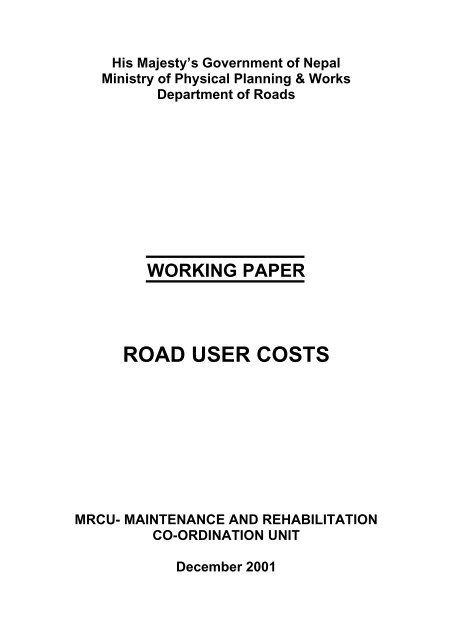
![j:6 ]zg cfof ]hgf](https://img.yumpu.com/51286794/1/190x245/j6-zg-cfof-hgf.jpg?quality=85)

![x'nfsL /fhdfu { cfof ]hgf](https://img.yumpu.com/50581959/1/190x245/xnfsl-fhdfu-cfof-hgf.jpg?quality=85)

